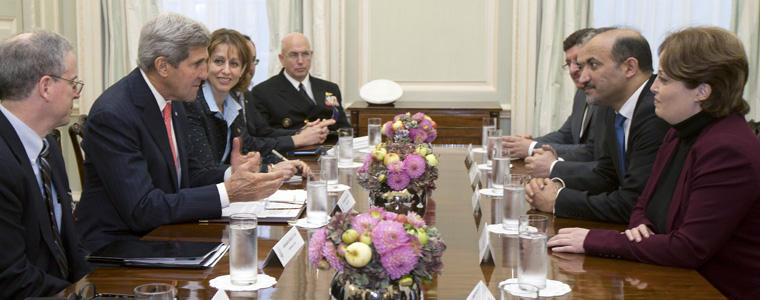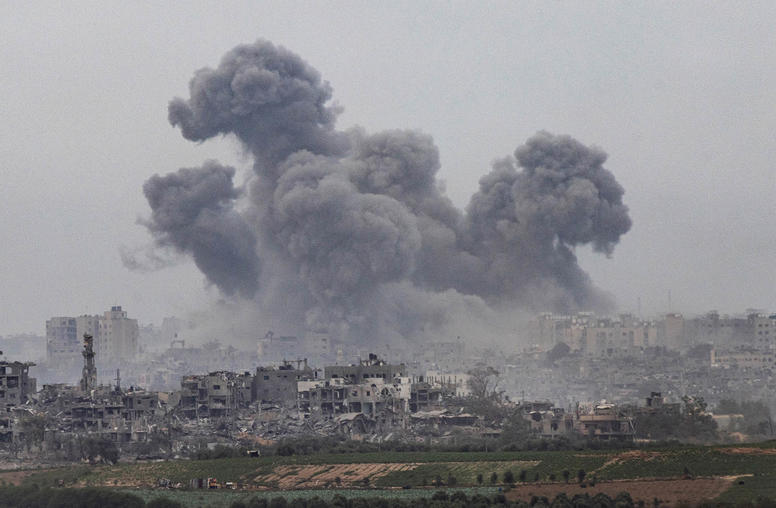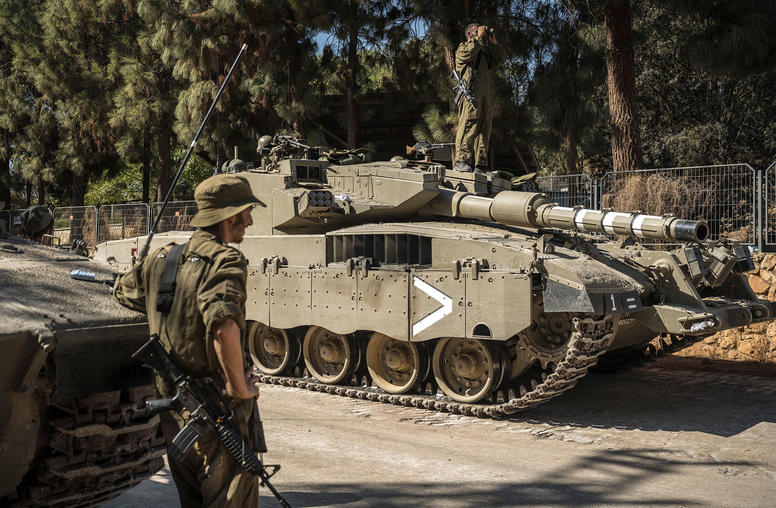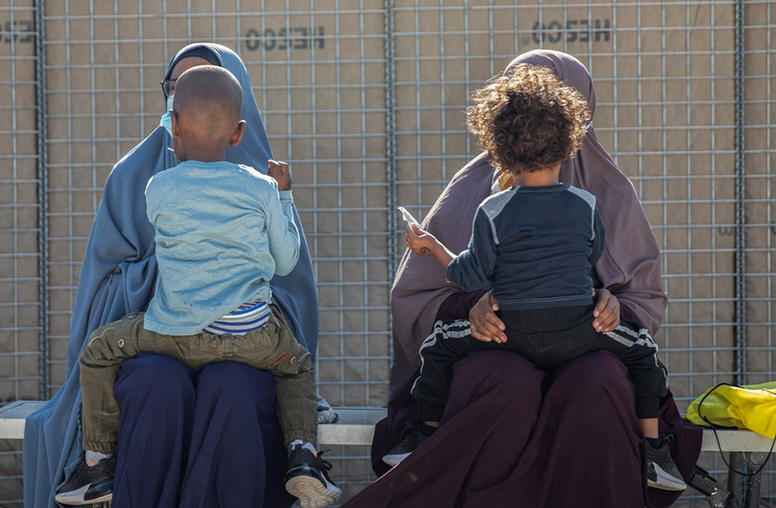Debate Lessons
From Sudan to Bosnia, what history can teach us about how to manage negotiations between the Syrian regime and opposition.
What can we learn from other peace processes that could help ease the negotiations in Geneva this January between the Syrian government and the country's fractured opposition? Many seasoned practitioners would argue that since no two conflicts are alike, it is dangerous to assume that what worked in managing one conflict will work in another. At the risk of proving the skeptics right, however, there are a few areas in which earlier conflicts might provide useful lessons for Geneva: identity issues, ripeness issues, and issues arising from the lack of cohesion among the opposition.

Identity issues. At first glance, the conflict in Syria seems to be over who has the authority to govern Syria and what the foundation for that authority is. During the early days of the conflict, the battle lines were set between an authoritarian government and "the street," resulting in a popular uprising against a dictatorial government. But these lines are not as clear today -- like many conflicts that preceded it, both in the region and around the world, Syria has become a conflict over legitimacy.
While removing President Bashar al-Assad remains the target of the opposition groups, the vision of the government that would replace the Assad regime differs greatly. If the next government were secular and democratic, would it be seen as legitimate among groups defined by their religious identity? If it were Islamic, would the liberal democracy promoters accept it as valid? Or would the various groups support only the government that represented their own culture, beliefs, and approach? In other words, has the Syrian conflict become an existential conflict -- one based on identity -- as well as a conflict over legitimacy?
If so, it is similar to many intractable conflicts that combined legitimacy and identity-based issues in a stubborn mix of conflict fuel, like Northern Ireland, Bosnia and the rest of the Balkans, and Sudan and South Sudan. Until they became crises, these conflicts developed without much outside intervention. When the internationals became involved, they dealt primarily with the legitimacy issues and left the identity-based issues to take care of themselves. While the violent conflicts in Northern Ireland, the Balkans, and Sudan and South Sudan have, for the most part, come to an end, the countries are still dealing with these consequences of this limited perspective.
As such, these conflicts offer a number of lessons: early action is important; late action requires a great deal of energy and resolve; once a conflict has aged into intractability, it is necessary to address identity-based issues lest the agreement over governance break down over sectarian or existential issues. Syria is a young conflict, but already shows characteristics of aging into intractability. Any attempt at resolution now should take into account both legitimacy and identity issues. Intractable conflicts become that way because new obstacles emerge that compound and aggravate the original ones, creating contradictory narratives and new layers of scar tissue.
What makes existential identity issues especially troublesome in the Syrian case is how they are linked to security dilemmas -- the fear that some groups are so strong that they threaten the viability of others or so weak that they cannot help to ward off threats. The common response to these dilemmas is to escalate both arms and capacity, in order to provide protection from increased security threats. But as one group escalates, its actions create a security dilemma for its neighbors, and soon they too are escalating to counteract the security threat they feel from the first group. Third party action, through helping the parties craft credible commitments, providing external guarantees, agreeing to cut off arms supplies, or aiding security sector reform, is essential in counteracting the escalatory effects of security dilemmas.
Ripeness issues. An important question that arises from previous conflicts is whether the parties to the conflict in are Syria ready to negotiate rather than continuing to fight. In other words, is the Syrian conflict ripe for resolution? Ripeness, according to I. William Zartman, professor emeritus at Johns Hopkins University, is the moment when conflict parties are ready to resolve their conflict. Without ripeness, conflicts can be managed, suppressed, or frozen, but they cannot be resolved. Moments of ripeness occur when there is a mutually hurting stalemate, when antagonists feel that, no matter how much the fighting escalates, they cannot overcome the other parties. But as conflicts in the Middle East, the Korea Peninsula, and Kashmir attest, stalemates can go on for a long time without producing resolution. Conflict parties also need a way out -- not just a solution, but a pathway to a future that is better than the current stalemate.
Ripeness only describes a moment when the parties are ready to negotiate, it does not guarantee success in those negotiations. It also rarely occurs spontaneously. Outsiders -- powerful states, the U.N., neighbors, regional organizations, NGOs -- often need to help conflict parties recognize their stalemates and ways out, using persuasive talk or the threat (or use) of force. Outsiders often have to put pressure on the process to keep negotiations going; they often have to help to build leadership and coherence within the conflict parties necessary to carry out negotiations and convince their constituents that they should accept the results.
With the recent escalation by the Syrian government and the reluctance of parties to come to Geneva, it is apparent that the Syrian conflict is far from ripe. The U.S. and other countries have tried to "ripen" the conflict through the dual threats of military force and the imposition of sanctions in an attempt to change the Syrian government's view of the costs and benefits of continuing to fight.
These tools have been effective, but there are also other tools that outsiders can employ. One of the most powerful is "borrowing" leverage from each other as the U.S. and Russia have done in their effort to get the Syrian sides to the negotiating table. This kind of diplomatic engagement needs to be nurtured, as Chester Crocker, professor at Georgetown and former State Department official, points out, not "to make nice," but to "open the door" to a possible agreement. In other words, engagement with erstwhile enemies or antagonists in pursuit of peacemaking is a deliberate move to increase leverage.
Crocker used this approach -- reaching out to his Russian counterparts -- to develop pressure on the parties as he negotiated the withdrawal of Cuban troops from Angola and the end to conflicts in southern Africa in the 1980s. Former Assistant Secretary of State Richard Solomon and his counterparts from China and Russia also borrowed leverage from each other to bring peace to Cambodia in the early 1990s. Borrowing leverage is not the same as forming an alliance. While it might be a real bonus if the engagement approach improves relations with former or current antagonists, the fundamental purpose of the engagement is to ripen a conflict.
Cohesion issues. A third challenge is defining which parties to deal with, particularly among a fractured opposition, as is the case in Syria now. The same problem can be found in the Belgrade-Kosovo conflict and the struggle between the government of the Philippines and the various break-away groups in Mindanao. It has also appeared, albeit in a somewhat different form, in the current Egyptian turmoil, as power passes back and forth between groups that firmly oppose the Mubarak regime but don't share a common platform, culture, or ideology.
In the Syrian case, this imbalance will affect negotiations. The government will present a single negotiating voice in the talks, while the fragmented opposition will find it hard to present a unified position. Unless the opposition groups are able to gather around a common set of goals and agree on a spokesperson, it will be very difficult for them to present a strong counterforce to the government's stance.
So how can third parties help to build unity among the opposition? Given time, outsiders can develop productive relationships not only with all of the opposition groups, but also with some of their sponsors -- at least those permitted by the Patriot Act and similar rulings by other countries and international organizations. Such talks, combined with pressure, might lead to the identification of common ground among opposition groups. This is similar to the strategy the U.S. took in pressuring the Bosniaks and the Croats to come together in an alliance, albeit an uneasy one, towards the end of the Bosnian war.
Outsiders could also engage in training and mentoring for the opposition parties on a one-by-one basis, hoping to talk each opposition fragment into recognizing the importance of a unified stand at the negotiating table. Third parties could also let the opposition parties fight it out until one or another emerged as the most powerful. Or they could side with one of the parties, providing arms and support to enable the recipient to defeat militarily all the other groups. Betting on one horse has worked in the past: President Hamid Karzai's ability to retain control over Afghanistan is in large part thanks to Western, largely American, support for his position. However, as the Karzai case suggests, these single-horse betting strategies also have their drawbacks if the horse refuses to run or proves hard to handle.
Whatever the strategy, the outsiders interested in managing the Syrian conflict should focus hard on bringing some kind of unity to the opposition parties. Without that, the negotiations could dissolve into a series of side agreements between the government and the various opposition groups, which would likely evaporate as soon as the negotiators returned to their increasingly radicalized communities.
Looking ahead, Geneva II does not have to produce a comprehensive agreement, but it does need to make progress on the framework provided by Geneva I. Without a sense of forward momentum, the talks may merely inflame the conflict, freeze positions, or provide an opportunity for all parties to be seen negotiating without obliging them to take difficult decisions. While the parties to the conflict and their supporters may be happy with one or all of these outcomes, they will make the next talks -- Geneva III -- even more difficult.
Reposted with permission from ForeignPolicy.com, Source: “Debate Lessons"



